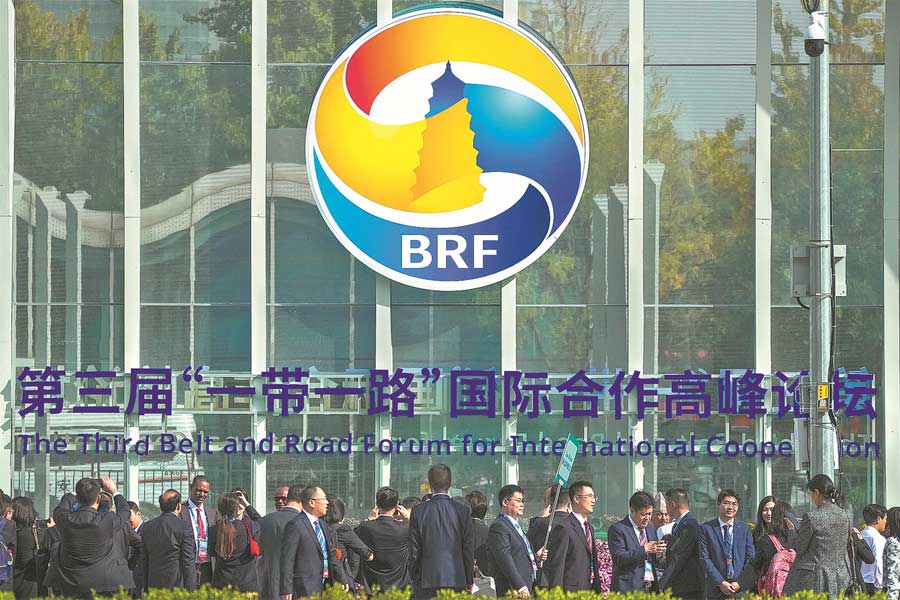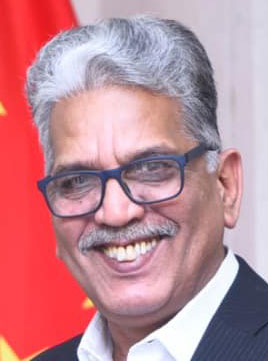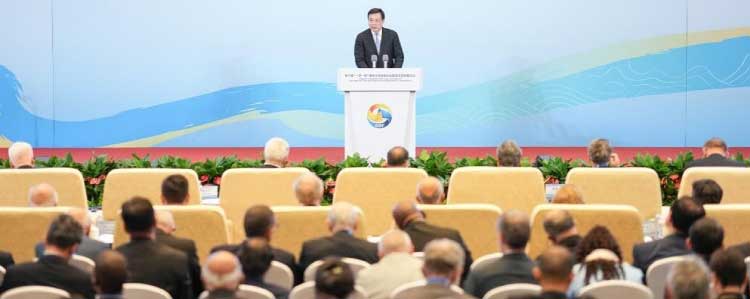
BRF 2023
Full text of Xi Jinping’s keynote speech at 3rd Belt and Road Forum for Int’l Cooperation
BEIJING: Chinese President Xi Jinping on Wednesday delivered a keynote speech at the third Belt and Road Forum for International Cooperation.
The following is the full text of the speech:
Building an Open, Inclusive and Interconnected World For Common Development
Keynote Speech by H.E. Xi Jinping
President of the People’s Republic of China
At the Opening Ceremony of the Third Belt and Road Forum for International Cooperation
October 18, 2023
Your Excellencies Heads of State and Government,
Heads of International Organizations,
Representatives of Various Countries,
Distinguished Guests,
Ladies and Gentlemen,
Friends,
Today, we are meeting here for the opening ceremony of the Third Belt and Road Forum for International Cooperation (BRF). On behalf of the Chinese government and Chinese people and in my own name, I wish to extend a very warm welcome to you all!
This year marks the 10th anniversary of the Belt and Road Initiative (BRI) I proposed. The BRI, drawing inspiration from the ancient Silk Road and focusing on enhancing connectivity, aims to enhance policy, infrastructure, trade, financial and people-to-people connectivity, inject new impetus into the global economy, create new opportunities for global development, and build a new platform for international economic cooperation.
Over these 10 years, we have stayed committed to this founding mission. Thanks to our joint efforts, Belt and Road international cooperation has gotten off the ground, grown rapidly and produced fruitful outcomes.
Belt and Road cooperation has extended from the Eurasian continent to Africa and Latin America. More than 150 countries and over 30 international organizations have signed Belt and Road cooperation documents. We have held two sessions of the BRF before, and have established over 20 specialized multilateral cooperation platforms under the BRI.
Belt and Road cooperation has progressed from “sketching the outline” to “filling in the details,” and blueprints have been turned into real projects. A large number of signature projects and “small yet smart” people-centered programs have been launched.
Belt and Road cooperation has expanded from physical connectivity to institutional connectivity. Important guiding principles for high-quality Belt and Road cooperation have been laid down, which include the principle of “planning together, building together, and benefiting together,” the philosophy of open, green and clean cooperation, and the goal of pursuing high-standard, people-centered and sustainable cooperation.
Over these 10 years, we have endeavored to build a global network of connectivity consisting of economic corridors, international transportation routes and information highway as well as railways, roads, airports, ports, pipelines and power grids. Covering the land, the ocean, the sky and the Internet, this network has boosted the flow of goods, capital, technologies and human resources among countries involved and injected fresh vitality into the millennia-old Silk Road in the new era.
Trains speeding along rail tracks, automobiles running on roads, flights connecting different countries, cargo ships breaking waves, and e-commerce bringing so much convenience to people — they have all become symbols of international trade in the new era, just like camel caravans and the sailing ships were for the past age.
Hydro, wind and solar energy based power plants, oil and gas pipelines, and the increasingly smart and interconnected power transmission networks are removing the development bottleneck caused by energy shortage and fulfilling the dream of developing countries to achieve green and low-carbon development. These energy projects have become the oasis and lighthouse for sustainable development in the new era.
Brand new airports and harbors, smooth roads, and newly built industrial parks for business cooperation have created new economic corridors and new growth drivers, and have become the trading routes and staging posts of the new era.
Rich and colorful cultural years, art festivals, expos and exhibitions, Luban Workshops, people-to-people exchange programs like the Silk Road Community Building Initiative and the Brightness Action program, and deepening exchanges between non-governmental organizations, think tanks, media organizations, and the youth — all these flourishing activities have composed a symphony of friendship in the new era.
When COVID-19 struck, the Belt and Road became a life-saving road. China provided more than 10 billion masks and 2.3 billion doses of vaccines to other countries and jointly produced vaccines with over 20 countries, making a special contribution to BRI partners’ efforts in fighting COVID-19. And China also received valuable support from more than 70 countries when it was hit hard by the pandemic.
Belt and Road cooperation is based on the principle of “planning together, building together, and benefiting together.” It transcends differences between civilizations, cultures, social systems, and stages of development. It has opened up a new path for exchanges among countries, and established a new framework for international cooperation. Indeed, the BRI represents humanity’s joint pursuit of development for all.
Ladies and Gentlemen,
Friends,
Our achievements in the past decade are truly remarkable, and there is so much we can draw from them.
We have learned that humankind is a community with a shared future. China can only do well when the world is doing well. When China does well, the world will get even better. Through Belt and Road cooperation, China is opening its door even wider to the world, with its inland regions turning from “fullbacks” into “forwards,” and coastal regions scaling new heights in their opening-up. China’s market has become even more closely integrated with the global market. China has become a main trading partner of more than 140 countries and territories and a primary source of investment for more countries. Both Chinese investment overseas and foreign investment in China have boosted friendship, cooperation, confidence and hope.
We have learned that win-win cooperation is the sure way to success in launching major initiatives that benefit all. When countries embrace cooperation and act in concert, a deep chasm can be turned into a thoroughfare, land-locked countries can become land-linked, and a place of underdevelopment can be transformed into a land of prosperity. Countries taking the lead in economic development should give a hand to their partners who are yet to catch up. We should all treat each other as friends and partners, respect and support each other, and help each other succeed. As the saying goes, when you give roses to others, their fragrance lingers on your hand. In other words, helping others is also helping oneself. Viewing others’ development as a threat or taking economic interdependence as a risk will not make one’s own life better or speed up one’s development.
We have learned that the Silk Road spirit of peace and cooperation, openness and inclusiveness, mutual learning and mutual benefit is the most important source of strength for Belt and Road cooperation. I once said that the pioneers of the ancient silk routes won their place in history not as conquerors with warships, guns, horses or swords. Rather, they are remembered as friendly emissaries leading camel caravans and sailing ships loaded with goods. Belt and Road cooperation is based on the belief that flame runs high when everyone adds wood to the fire and that mutual support can get us far. Such cooperation seeks to deliver a good life not only to people of just one country, but to people in other countries as well. It promotes connectivity, mutual benefit, common development, cooperation and win-win outcomes. Ideological confrontation, geopolitical rivalry and bloc politics are not a choice for us. What we stand against are unilateral sanctions, economic coercion and decoupling and supply chain disruption.
What has been achieved in the past 10 years demonstrates that Belt and Road cooperation is on the right side of history. It represents the advancing of our times, and it is the right path forward. We need to remain clear-eyed and undisturbed in a volatile world, and we need to be keenly aware of our responsibility for history, for the people and for the world. We should jointly address various global risks and challenges, and deliver a bright future of peace, development, cooperation and mutual benefit for future generations.
Ladies and Gentlemen,
Friends,
Changes of the world, of our times, and of historical significance are unfolding like never before. China is endeavoring to build itself into a stronger country and rejuvenate the Chinese nation on all fronts by pursuing Chinese modernization. The modernization we are pursuing is not for China alone, but for all developing countries through our joint efforts. Global modernization should be pursued to enhance peaceful development and mutually beneficial cooperation and bring prosperity to all. On our way forward, we will encounter both headwinds and tailwinds. We need to stay focused on our goal, take results-oriented actions, persevere, and keep moving forward until our goal is met. China will work with all parties involved to deepen Belt and Road partnerships of cooperation, usher this cooperation into a new stage of high-quality development, and make relentless efforts to achieve modernization for all countries.
Now, I wish to announce eight major steps China will take to support our joint pursuit of high-quality Belt and Road cooperation.
First, building a multidimensional Belt and Road connectivity network. China will speed up high-quality development of the China-Europe Railway Express, participate in the trans-Caspian international transportation corridor, host the China-Europe Railway Express Cooperation Forum, and make joint efforts to build a new logistics corridor across the Eurasian continent linked by direct railway and road transportation. We will vigorously integrate ports, shipping and trading services under the “Silk Road Maritime,” and accelerate the building of the New International Land-Sea Trade Corridor and the Air Silk Road.
Second, supporting an open world economy. China will establish pilot zones for Silk Road e-commerce cooperation, enter into free trade agreements and investment protection treaties with more countries. We will remove all restrictions on foreign investment access in the manufacturing sector. In light of international high-standard economic and trade rules, we will further advance high-standard opening up in cross-border service trade and investment, expand market access for digital and other products, and deepen reform in areas including the state-owned enterprises, digital economy, intellectual property and government procurement. China will hold the Global Digital Trade Expo annually. In the next five years (2024-2028), China’s total trade in goods and services is expected to exceed USD 32 trillion and USD 5 trillion respectively.
Third, carrying out practical cooperation. China will promote both signature projects and “small yet smart” livelihood programs. The China Development Bank and the Export-Import Bank of China will each set up a RMB 350 billion financing window. An additional RMB 80 billion will be injected into the Silk Road Fund. Together, they will support BRI projects on the basis of market and business operation. Cooperation agreements worth USD 97.2 billion have been concluded at the CEO Conference held during this Forum. China will carry out 1,000 small-scale livelihood assistance projects, and enhance vocational education cooperation through Luban Workshops and other initiatives. We will also step up joint efforts to ensure the safety of BRI projects and personnel.
Fourth, promoting green development. China will continue to deepen cooperation in areas such as green infrastructure, green energy and green transportation, and step up support for the BRI International Green Development Coalition. China will continue to hold the BRI Green Innovation Conference, and establish dialogue and exchange mechanisms for the solar industry and a network of experts on green and low-carbon development. China will implement the Green Investment Principles for the Belt and Road, and provide 100,000 training opportunities for partner countries by 2030.
Fifth, advancing scientific and technological innovation. China will continue to implement the Belt and Road Science, Technology and Innovation Cooperation Action Plan, hold the first Belt and Road Conference on Science and Technology Exchange, increase the number of joint laboratories built with other parties to 100 in the next five years, and support young scientists from other countries to work on short-term programs in China. At this Forum, China will put forward the Global Initiative for Artificial Intelligence (AI) Governance. We stand ready to increase exchanges and dialogue with other countries and jointly promote the sound, orderly and secure AI development in the world.
Sixth, supporting people-to-people exchanges. China will host the Liangzhu Forum to enhance dialogue on civilizations with BRI partner countries. In addition to the Silk Road International League of Theaters, the Silk Road International Arts Festival, the International Alliance of Museums of the Silk Road, the Silk Road International Alliance of Art Museums, and the Silk Road International Library Alliance that have been set up, China has also launched the International Tourism Alliance of Silk Road Cities. And we will continue with the Chinese government scholarship Silk Road Program.
Seventh, promoting integrity-based Belt and Road cooperation. Together with its cooperation partners, China will release the Achievements and Prospects of Belt and Road Integrity Building and the High-Level Principles on Belt and Road Integrity Building, and establish the Integrity and Compliance Evaluation System for Companies Involved in Belt and Road Cooperation. We will also work with international organizations to carry out research and training on promoting integrity in Belt and Road cooperation.
Eighth, strengthening institutional building for international Belt and Road cooperation. China will work with its BRI partner countries to strengthen the building of multilateral cooperation platforms covering energy, taxation, finance, green development, disaster reduction, anti-corruption, think tank, media, culture and other fields. China will continue to host the BRF and establish a secretariat for the Forum.
Ladies and Gentlemen,
Friends,
The past decade has been a journey of dedicated cooperation and fruitful outcomes. Belt and Road cooperation was proposed by China, but its benefits and opportunities are for the world to share. Let us meet the expectations of the people, assume responsibilities entrusted on us by history, closely follow the trend of the times, and press ahead with energy and enterprise. Let us deepen Belt and Road international cooperation, and bring Belt and Road cooperation to a new stage of higher-quality and higher-level development. Let us advance modernization of all countries, build an open, inclusive and interconnected world for common development, and jointly build a community with a shared future for mankind.
I wish the Third Belt and Road Forum for International Cooperation a full success!
Thank you.
Foreign leaders pledge to promote high-quality Belt and Road cooperation
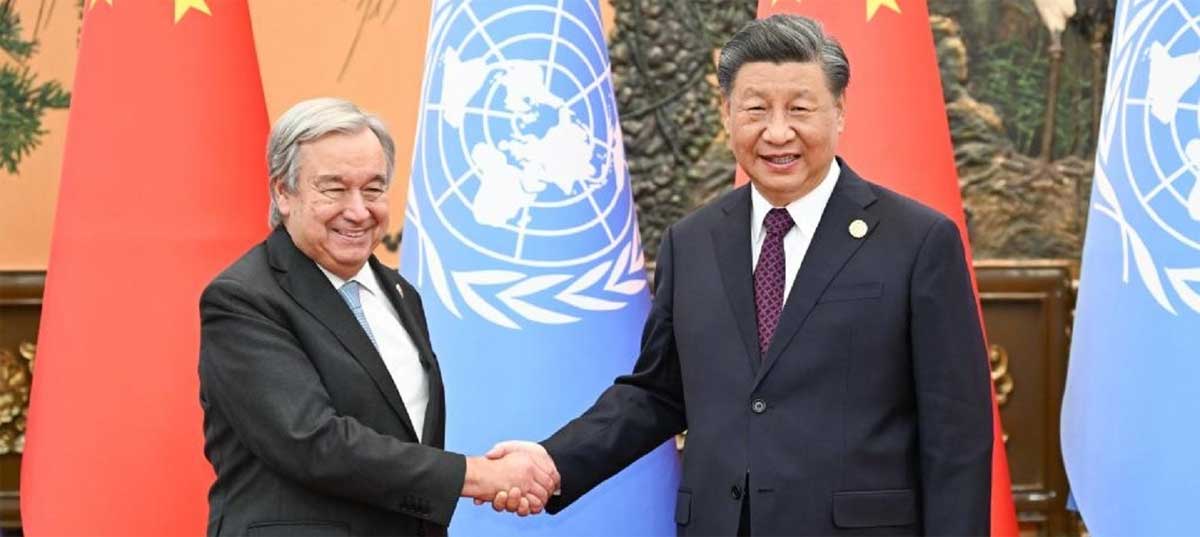
BEIJING: China-proposed Belt and Road Initiative (BRI) has effectively promoted the progress of our planet, said foreign leaders and experts, vowing to deepen Belt and Road cooperation to achieve higher-quality and higher-level common development in the next “golden decade.”
Russian President Vladimir Putin said the BRI has achieved great success and has become an important international public good widely recognized by the world, expressing his confidence in greater achievements of this great cause.
He added that Russia is willing to strengthen communication and collaboration with China within multilateral mechanisms such as BRICS, uphold the international system based on international law, and promote the establishment of a more just and reasonable global governance system.
Kazakh President Kassym-Jomart Tokayev said here Wednesday that Kazakhstan plans to build 1,300 km of new railways in the next three years in synergy with the Belt and Road Initiative.
“Following the fundamental interests of the people of Kazakhstan and China, the spirit of friendship and eternal strategic partnership, our country is firmly committed to further promoting the high goals of the Belt and Road Initiative,” Tokayev said at the opening of the third Belt and Road Forum for International Cooperation.
“Within three years, we plan to build 1,300 km of new railway tracks. We are going to open a third railway border crossing on the Kazakh-Chinese border, as well as build new dry ports,” Tokayev said.
“All of these are real examples of the coupling of major economic projects in Kazakhstan” with the BRI, the president added.
Indonesian President Joko Widodo also called on all partner countries to collectively make the BRI stronger and more impactful.
“I would like to thank the Chinese government and President Xi Jinping for their contributions to developing countries through the BRI. I hope the synergy of BRI in infrastructure development can always be strengthened,” said Widodo on Wednesday at the opening ceremony of the third Belt and Road Forum for International Cooperation held in Beijing.
During his speech, Widodo mentioned Indonesia’s newly-launched and operated Jakarta-Bandung High-Speed Railway, a flagship project under the scheme of the BRI.
“Let’s move forward persistently together to promote economic development and realize people’s welfare,” Widodo said.
Hailing China as a “true friend” of Argentina, President Alberto Fernandez said the Belt and Road cooperation has created important opportunities for developing countries and played an irreplaceable role in promoting world peace, fairness and sustainable development.
Argentina will work with China to support multilateralism and strengthen communication and coordination within the frameworks of the G20 and BRICS cooperation mechanism, Fernandez said.
Ethiopian Prime Minister Abiy Ahmed said Wednesday that as one of the largest transnational infrastructure programs, the BRI is facilitating integration and sustainable growth.
Large-scale investments in infrastructure and strengthened commercial ties have boosted the continent’s economic development, Ahmed said.
UN Secretary-General Antonio Guterres said on Wednesday that projects under the BRI are changing landscapes and helping improve livelihoods worldwide.
Guterres added the concept of Green Silk Road under the BRI provides an important opportunity to fast-track sustainable and climate-resilient development to protect lives and livelihoods.
The Green Silk Road can be a critical part of this process to fast-track a fair, equitable and just energy transition, said the UN chief.
Chinese FM hails fruitful results of 3rd BRF
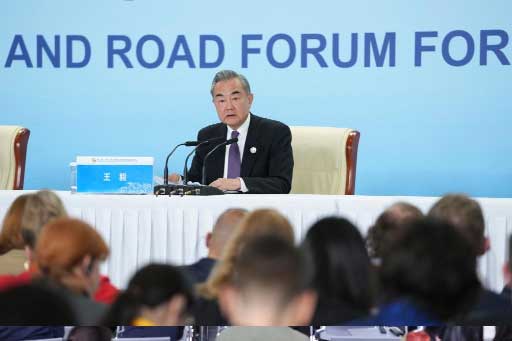
BEIJING: The third Belt and Road Forum for International Cooperation (BRF) marks another important milestone in the process of jointly building the Belt and Road, Chinese Foreign Minister Wang Yi said Wednesday, calling the forum a “complete success.”
“The most important consensus reached at this forum is to open a new stage of high-quality Belt and Road cooperation,” Wang, also a member of the Political Bureau of the Communist Party of China Central Committee, said at a press conference.
Wang noted that the new stage of cooperation is bound to create even more new opportunities for the global economy and become a boon for the global situation.
“The greatest vision of this forum is to jointly modernize the world,” Wang said. “The Belt and Road Initiative (BRI) has created a cooperation platform for common development and helped many developing countries speed up their march toward modernization.”
During the forum, a total of 458 outcomes were achieved, far more than the second BRF, Wang added.
Over the past 10 years, Wang noted, the Belt and Road cooperation has made historic achievements, opening up a road of cooperation, opportunity and prosperity leading to common development.
The BRI has become the most popular international public good and the largest international cooperation platform in the world today, Wang said.
Wang added that the Belt and Road is an open platform and every country is welcome to take part in it at any time.
He expressed the hope that connectivity initiatives of other countries also remain open and refrain from creating exclusive cliques.
China stands ready to align with all other connectivity initiatives, Wang said.
At the press conference, Wang also dismissed the claim that the U.S.-launched Partnership for Global Infrastructure and Investment is targeted at the Belt and Road, calling the narrative another case of politicizing economic issues.


